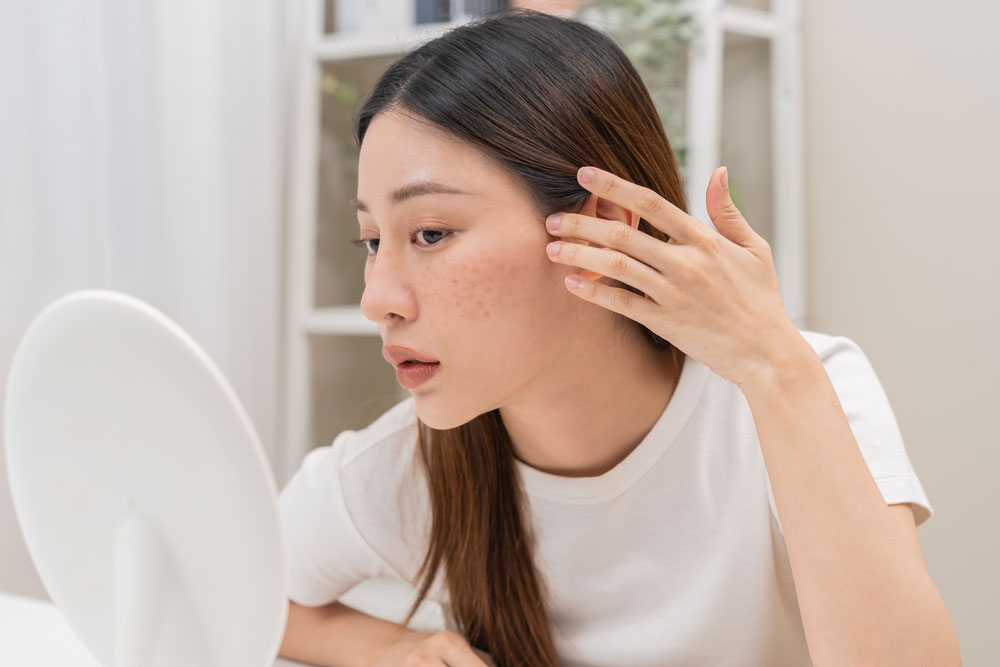Redness and sun damage can affect anyone, whether from prolonged sun exposure, rosacea, or lingering effects of past breakouts. These skin concerns often lead to uneven tone and persistent discoloration that may not fade on their own. Over-the-counter products may provide temporary relief, but they don’t always address the underlying issue.
At Worcester Dermatology Associates, we offer intense pulsed light treatments in Worcester and Chelmsford, MA, to help reduce redness and pigmentation. This light-based treatment targets unwanted pigmentation and broken capillaries, allowing the skin to gradually clear. With minimal downtime, it provides an easy way to improve skin tone and restore a more balanced complexion.
What Causes Skin Redness?
Skin redness can come from different sources, and the cause isn’t always obvious. Conditions like rosacea, broken capillaries, and lingering inflammation from acne can leave the skin looking persistently flushed. Sun damage is another common reason since UV exposure can weaken blood vessels over time. Some redness fades on its own, but in many cases, it sticks around without treatment.
Types of Skin Redness
Rosacea
Rosacea is a chronic condition that causes persistent redness, visible blood vessels, and occasional flare-ups of inflammation. It often affects the cheeks, nose, chin, and forehead and becomes more noticeable over time. Triggers like heat, alcohol, and spicy foods can make symptoms worse, but the exact cause of rosacea is still unknown.
Broken Capillaries and Visible Veins
Small, broken blood vessels can appear as red or purple lines on the skin and can be caused by sun exposure, aging, or pressure from repeated facial flushing. These tiny veins don’t heal on their own, but light-based treatments can shrink them and make them less noticeable.
Post-Inflammatory Hyperpigmentation
After acne, rashes, or other skin injuries heal, they can leave behind stubborn redness or discoloration. This happens when inflammation triggers excess melanin production, creating red or brown spots that linger long after the initial issue fades.
Skin Sensitivity
Some people experience redness due to an overactive response to skincare products, weather changes, or environmental factors. This type of redness can be temporary but may become persistent with repeated irritation.
The Effects of Sun Damage on the Skin
Sun damage builds up over time, even if a sunburn isn’t always visible. UV exposure weakens the skin’s supportive structures, causing fine lines, rough texture, and uneven pigmentation. Redness often develops as blood vessels become more fragile and more noticeable beneath the surface. Sunspots and blotchy discoloration can also appear and cause the skin to look uneven and aged.
Why Treat Redness and Sun Damage?
Aesthetic Improvements
Reducing redness and uneven pigmentation can create a more balanced complexion and make your skin tone appear smoother and more uniform. Areas that once looked flushed or blotchy can blend more naturally with surrounding skin. Addressing these concerns can also make makeup application easier since less coverage is needed to even out skin tone.
Supporting Long-Term Skin Health
Clearing away redness and pigmentation helps maintain healthier skin by reducing ongoing irritation and inflammation. Strengthening the skin’s barrier can make it more resilient, limiting the effects of environmental stressors that contribute to redness over time. Managing sun damage can also prevent new pigmentation issues from developing. Treating these concerns early can support overall skin function and promote clearer, healthier skin as you age.
What Is IPL and How Does It Work?
Intense pulsed light therapy uses broad-spectrum light to target unwanted pigmentation and visible blood vessels beneath the skin’s surface. Unlike lasers, which use a single wavelength, IPL delivers multiple wavelengths of light that penetrate different layers of the skin. The light is absorbed by melanin in sunspots and hemoglobin in blood vessels, breaking them down so the body can naturally clear them away.
How IPL Treats Redness and Sun Damage
IPL therapy addresses redness by collapsing dilated blood vessels that cause flushing and visible veins. The heat energy from the light shrinks these vessels and makes them less noticeable over time. For sun damage, intense pulsed light targets clusters of excess melanin that create dark spots and uneven pigmentation. As these pigment particles break apart, the skin gradually becomes clearer and more uniform in tone.
The IPL Treatment Process
A layer of cooling gel is applied to the skin before IPL therapy begins to help conduct the light and minimize discomfort. The handheld device delivers controlled pulses of light, which may create a mild warming or snapping sensation. The entire session typically takes about 30 minutes, depending on the treatment area. Redness and dark spots may initially darken before fading as the body works to clear the targeted pigment and blood vessels.
Maintaining Your Results After IPL Treatments
Sun protection is the most effective way to keep redness and pigmentation from returning after treatment. Daily use of a broad-spectrum sunscreen with SPF 30 or higher helps prevent new sun damage and keeps existing discoloration from worsening. Skincare products with ingredients like vitamin C and niacinamide can also support skin tone by reducing inflammation and inhibiting excess pigment production. Some patients may benefit from maintenance IPL treatments every few months to manage chronic redness or sun damage that continues to develop over time.
Schedule an IPL Treatment for Clear, Even Skin
Intense pulsed light therapy can help reduce redness and sun damage by targeting excess pigment and broken blood vessels beneath the skin. Treatments are quick, require little to no downtime, and can be repeated as needed to maintain long-term results. To schedule a consultation at Worcester Dermatology Associates in Worcester and Chelmsford, MA, call (508) 754-3823 or contact us through the online form.

